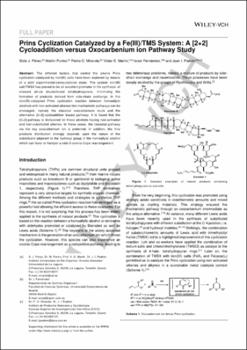Prins Cyclization Catalyzed by a FeIII/Trimethylsilyl Halide System: The Oxocarbenium Ion Pathway versus the [2+2] Cycloaddition
Date
2015Abstract
The different factors that control the alkene Prins cyclization catalyzed by iron(III) salts have been explored by means of a joint experimental¿computational study. The iron(III) salt/trimethylsilyl halide system has proved to be an excellent promoter in the synthesis of crossed all-cis disubstituted tetrahydropyrans, minimizing the formation of products derived from side-chain exchange. In this iron(III)-catalyzed Prins cyclization reaction between homoallylic alcohols and non-activated alkenes, two mechanistic pathways can be envisaged, namely the classical oxocarbenium route and the alternative [2+2] cycloaddition-based pathway. It is found that the [2+2] pathway is disfavored for those alcohols having non-activated and non-substituted alkenes. In these cases, the classical pathway, via the key oxocarbenium ion, is preferred. In addition, the final product distribution strongly depends upon the nature of the substituent adjacent to the hydroxy group in the homoallylic alcohol, which can favor or hamper a side 2-oxonia-Cope rearrangement.





